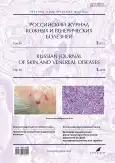Treatment of moderate papulopustular acne with systemic doxycycline and the novel fourth-generation topical retinoid trifarotene
- Authors: Snarskaya E.S.1, Olisova O.Y.1, Bratkovskaya A.V.1
-
Affiliations:
- The First Sechenov Moscow State Medical University (Sechenov University)
- Issue: Vol 28, No 3 (2025)
- Pages: 249-258
- Section: DERMATOLOGY
- URL: https://bakhtiniada.ru/1560-9588/article/view/313072
- DOI: https://doi.org/10.17816/dv678363
- EDN: https://elibrary.ru/YYECMP
- ID: 313072
Cite item
Abstract
Acne vulgaris is a prevalent chronic inflammatory skin disorder that significantly impacts patients’ quality of life and necessitates effective and safe therapeutic strategies.
This article presents an analysis of current scientific sources and clinical experience regarding the use of the novel fourth-generation topical retinoid trifarotene (50 μg/g cream) in combination with systemic doxycycline for the treatment of moderate to severe papulopustular acne. A systematic review of scientific data highlights the unique mechanisms of trifarotene, particularly its high selectivity for the retinoic acid receptor gamma (RAR-γ). The antibacterial and anti-inflammatory properties of doxycycline, which enhance trifarotene’s therapeutic effects by inhibiting Cutibacterium acnes proliferation and reducing inflammatory cytokine production, are also discussed. The authors share their clinical experience, demonstrating the high efficacy and favorable safety profile of this combined treatment in patients with moderate facial and truncal acne.
The combination of trifarotene (50 μg/g) and systemic doxycycline offers proven clinical benefits, good tolerability, and a low risk of adverse events. Collective evidence from both Russian and international studies supports the recommendation of trifarotene and doxycycline combination therapy as an effective and safe approach with strong potential for widespread implementation in contemporary dermatologic practice.
Keywords
Full Text
##article.viewOnOriginalSite##About the authors
Elena S. Snarskaya
The First Sechenov Moscow State Medical University (Sechenov University)
Email: snarskaya-doc@mail.ru
ORCID iD: 0000-0002-7968-7663
SPIN-code: 3785-7859
MD, Dr. Sci. (Medicine), Professor
Russian Federation, MoscowOlga Yu. Olisova
The First Sechenov Moscow State Medical University (Sechenov University)
Email: olisovaolga@mail.ru
ORCID iD: 0000-0003-2482-1754
SPIN-code: 2500-7989
MD, Dr. Sci. (Medicine), Professor, Corresponding Member of the Russian Academy of Sciences
Russian Federation, MoscowAnna V. Bratkovskaya
The First Sechenov Moscow State Medical University (Sechenov University)
Author for correspondence.
Email: annabratk24@gmail.com
ORCID iD: 0000-0002-7284-9113
SPIN-code: 6012-7555
Russian Federation, Moscow
References
- Clinical Guidelines. Acne vulgaris. Russian Society of Dermatovenerologists and Cosmetologists; 2020. Available at: https://www.rodv.ru/klinicheskie-rekomendacii Accessed: Dec 12, 2024.
- Saurat JH, Halioua B, Baissac C, et al. Epidemiology of acne and rosacea: A worldwide global study. J Am Acad Dermatol. 2024;90(5):1016–1018. doi: 10.1016/j.jaad.2023.12.038.
- Issa N, Alexis A, Baldwin H, et al. Recommendations to improve outcomes in acne and acne sequelae: A focus on trifarotene and other retinoids. Dermatol Ther (Heidelb). 2025;15(3):563–577. doi: 10.1007/s13555-025-01344-y
- Del Rosso JQ, Bikowski JB, Baum E, et al. A closer look at truncal acne vulgaris: Prevalence, severity, and clinical significance. J Drugs Dermatol. 2007;6(6):597–600.
- Tan JK, Tang J, Fung K, et al. Prevalence and severity of facial and truncal acne in a referral cohort. J Drugs Dermatol. 2008;7(6):551–556.
- Samuels DV, Rosenthal R, Lin R, et al. Acne vulgaris and risk of depression and anxiety: A meta-analytic review. J Am Acad Dermatol. 2020;83(2):532–541. doi: 10.1016/j.jaad.2020.02.040
- Hughes O, Bewley A. Is it really ever ‘just acne’? Considering the psychodermatology of acne. Br J Dermatol. 2023;189(Suppl_1):i11–i16. doi: 10.1093/bjd/ljad251
- Ju Q, Fan WX, Gu J, et al. Chinese guidelines for the management of acne vulgaris: 2019 Update. Int J Derm Venereol. 2019;2(3):129–138. doi: 10.1097/JD9.0000000000000043
- Reynolds RV, Yeung H, Cheng CE, et al. Guidelines of care for the management of acne vulgaris. J Am Acad Dermatol. 2024;90(5):1006.e1–1006.e30. doi: 10.1016/j.jaad.2023.12.017
- Thoreau E, Arlabosse JM, Bouix-Peter C, et al. Structure-based design of Trifarotene (CD5789), a potent and selective RAR-γ agonist for the treatment of acne. Bioorg Med Chem Lett. 2018;28(10):1736–1741. doi: 10.1016/j.bmcl.2018.04.036
- Fisher GJ, Voorhees JJ. Molecular mechanisms of retinoid actions in skin. FASEB J. 1996;10(9):1002–1013. doi: 10.1096/fasebj.10.9.8801161
- Aubert J, Piwnica D, Bertino B, et al. Nonclinical and human pharmacology of the potent and selective topical retinoic acid receptor-γ agonist trifarotene. Br J Dermatol. 2018;179(2):442–456. doi: 10.1111/bjd.16719
- Tan J, Chavda R, Baldwin H, Dreno B. Management of acne vulgaris with trifarotene. J Cutan Med Surg. 2023;27(4):368–374. doi: 10.1177/12034754231163542
- Dreno B, Chavda R, Julia V, et al. Transcriptomics analysis indicates trifarotene reverses acne-related gene expression changes. Front Med (Lausanne). 2021;8:745822. doi: 10.3389/fmed.2021.745822
- Tan J, Thiboutot D, Popp G, et al. Randomized phase 3 evaluation of trifarotene 50 μg/g cream treatment of moderate facial and truncal acne. J Am Acad Dermatol. 2019;80(6):1691–1699. doi: 10.1016/j.jaad.2019.02.044
- Blume-Peytavi U, Fowler J, Kemény L, et al. Long-term safety and efficacy of trifarotene 50 μg/g cream, a first-in-class RAR-γ selective topical retinoid, in patients with moderate facial and truncal acne. J Eur Acad Dermatol Venereol. 2020;34(1):166–173. doi: 10.1111/jdv.15794
- Del Rosso JQ, Johnson SM, Schlesinger T, et al. A randomized, controlled trial of trifarotene plus doxycycline for severe acne vulgaris. J Clin Aesthet Dermatol. 2022;15(7):E53–E59.
- Baldwin H. Oral antibiotic treatment options for acne vulgaris. J Clin Aesthet Dermatol. 2020;13(9):26–32.
- Del Rosso JQ, Lain E, York JP, Alexis A. Trifarotene 0.005% cream in the treatment of facial and truncal acne vulgaris in patients with skin of color: A case series. Dermatol Ther (Heidelb). 2022;12(9):2189–2200. doi: 10.1007/s13555-022-00788-w
- Kassir M, Karagaiah P, Sonthalia S, et al. Selective RAR agonists for acne vulgaris: A narrative review. J Cosmet Dermatol. 2020;19(6):1278–1283. doi: 10.1111/jocd.13340
Supplementary files












